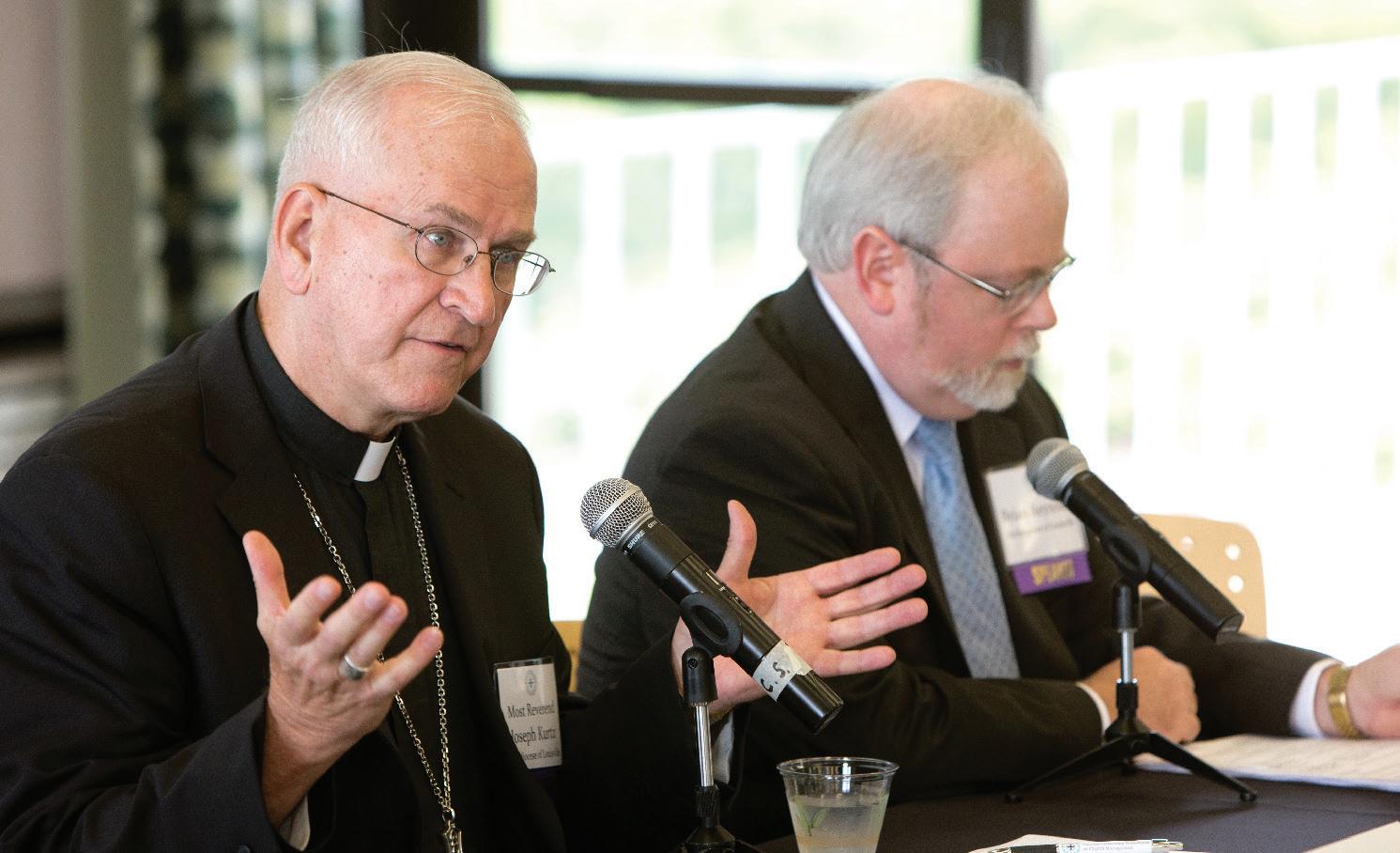
3 minute read
SELECTED QUESTIONS, ANSWERS, AND COMMENTS
like many organizations, with a key group of five or six people. My first question is: How does that leadership decision-making group interface with your consultative bodies? And my second question is: How did you deal with the fact the Archbishop has two full-time jobs at this point?
Archbishop Kurtz
KEVIN CARTON Trustee, The Leadership Roundtable

As we begin our tenth year of operations, what do you think the Roundtable should do next?
Brian Reynolds
Your question brings me back to the notion of building relationships. I don’t know if the Roundtable has enough ambassadors yet. But to tell everybody at your conference to go out and spread the word about the Roundtable won’t get you anywhere, because people will think that others are going to do the job. You need a select number of people to be your initiators, your ambassadors. That will empower them.
JEFF VON ARX President, Fairfield University
The leadership organization you’ve described in the Archdiocese functions,
The second question might be the easier one, so I’ll start with it. Brian and I and our staff presumed over the last year or so I would become president [of the U.S. Conference of Catholic Bishops] since I had been vice president. So, if we weren’t prepared, it would be our own fault. We began to look early on at areas that would free up some of my time. A metaphor that comes to mind is elastic borders – the notion that it actually is to our benefit as a diocese to have not only a bishop but other people involved in the larger Church community. We’ve had a very glorious experience in Louisville with people who have taken lead- ership roles beyond the Archdiocese. To be able to cite those and say we anticipate deriving the same benefits is a strong statement. Of course there will always be challenges with travel and so forth, but overall we see my national role as a benefit. It gives us an opportunity to have some input, and hopefully some impact, on decisions beyond the Archdiocese. And it certainly gives us the opportunity to learn from the experiences that I and others bring back.
Brian Reynolds
I’ll try to address your first question. When our leadership group meets with the Pastoral Council of the diocese, the critical question or two might dictate who else has to be there. The Archbishop always addresses them first, and they get to dialogue with him. My focus is to get to the critical questions. And if it’s a question that relates to communication at the diocese, say, we’ll have our communications director with us. So it’s not just the two of us meeting with the Pastoral Council. We involve in the consultative process whoever the key players are.
Archbishop Kurtz
I would add that the pressure is on us to ask the right critical questions. And that may mean bringing in people ahead of time to consult with us on how to ask the right questions. There may be cases where it’s as important to have a consultant help you to identify the question as it is to moderate the conversation. So, we often front-load our involvement by spending as much time as we can on that critical question. There should be no surprises at the actual meeting. People shouldn’t be able to say, “You just sprung that on me.”
Carol Fowler
This may be the elephant-in-the-room kind of question, but we’ve all noticed that one of you is a bishop and the other is a lay person. It couldn’t have been automatic that this kind of partnership would work. How did you manage to work that out?
Archbishop Kurtz
After I got my degree in social work, I became the Director of the Social Action Bureau in the Allentown Diocese. And that was really the first time I interacted with not just lay people, but with lay women. That was a very good and instructive experience for me, followed by my work with Catholic Charities. So maybe coming from a social work background where there has traditionally been less priestly and more lay involvement better prepared me to work with a lay partner like Brian. When I first arrived at the diocese, we had no idea what the outcome would be. But we decided to give it a good faith effort, and I’m very grateful that we did.
Brian Reynolds
I’ve been in the diocese for 25 years. I did strategic planning and HR work before I was named Chancellor in 2002 by Archbishop Kurtz’s predecessor, Archbishop Kelly. When Archbishop Kurtz came, I said to him, “I love our diocese, but I defer to you, Archbishop. Would you prefer a new Chancellor?” And he said, “We’re not going to have that conversation now. Let’s give each other six months. You may learn you don’t want to be here!” So, the assumption we started with was the need to work together for the sake of the mission and build from there.
National Leadership Roundtable on Church Management
2014 Annual Meeting
The Standard for Excellence:
BEST PRACTICES FOR A MISSION DRIVEN CHURCH
Loyola University Chicago | Lake Shore Campus | June 24-26, 2014 www.TheLeadershipRoundtable.org/AnnualMeeting







